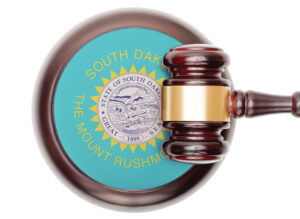Essays from a broad range of perspectives on bar admissions-related topics, with the goal of stimulating conversation and promoting understanding among the different stakeholders in bar admissions.
This article originally appeared in The Bar Examiner print edition, Summer/Fall 2021 (Vol. 90, Nos. 2–3), pp. 42–44.By Hon. David Gilbertson
 Life is full of ironies. For 25 years, I was a member of the South Dakota Supreme Court. For 20 of those years, I served five terms as Chief Justice. Pursuant to the South Dakota Constitution, the Court—and its Chief Justice, as the Court’s administrative head—oversee admission to the bar, which includes overseeing the South Dakota Bar Exam. The irony? I have never taken a bar exam. When I graduated from the University of South Dakota School of Law in 1975, its graduates were admitted under diploma privilege.
Life is full of ironies. For 25 years, I was a member of the South Dakota Supreme Court. For 20 of those years, I served five terms as Chief Justice. Pursuant to the South Dakota Constitution, the Court—and its Chief Justice, as the Court’s administrative head—oversee admission to the bar, which includes overseeing the South Dakota Bar Exam. The irony? I have never taken a bar exam. When I graduated from the University of South Dakota School of Law in 1975, its graduates were admitted under diploma privilege.
During my tenure as a Justice of the Supreme Court, the court system in South Dakota transitioned from a reactive system to a proactive system. The same is true with bar admissions. Despite my own path to admission to the South Dakota bar, I believe that the bar exam performs an important function in attorney admissions. I have also always believed that the bar should mirror the public it serves and provide for the underserved. To that end, the issues of good moral character and the composition of the bar exam have taken on increasing importance as public protection measures, especially when South Dakota saw a significant decline in bar passage rates from 2015 to 2018.1 During my tenure on the Supreme Court, I worked to improve access to justice in South Dakota by ensuring that the bar exam supports that goal and by strengthening the character and fitness process—both important parts of the Court’s regulatory role to ensure that the underserved of South Dakota have access to competent, ethical attorneys to serve their needs.
A Little Background about South Dakota’s Population
South Dakota has 64 counties with courthouses. Forty-eight of those counties have fewer than 10,000 residents. These rural counties have slowly been losing their practicing attorneys. The majority of new attorneys choose to locate in just four urban counties. As I told the South Dakota Legislature in my 2009 State of the Judiciary Message, “The real and sad truth is that we are heading toward a state that will not provide justice for all no matter the location. We are heading for a state which contains islands of justice in a sea of empty rural courthouses.”2
There is significant tension between the desperate need for legal assistance in communities and ensuring that those receiving a license to practice law are truly fit to fill that need. My philosophy has always been that greater harm will come to those in need if the solution is nothing but a placebo that comes in the form of an unqualified or unscrupulous attorney. That is why the Supreme Court has repeatedly resisted efforts to “lower the bar” to admissions in the name of solving this problem. Instead, we have looked for solutions that will incentivize qualified individuals to provide competent professional help to our underserved communities.
Access to Justice for South Dakota’s Rural Communities
In 2013 I made a legislative proposal that we initiate a program to encourage law students and recent graduates to establish solo practices in underserved rural counties. I came from one of those counties and knew that there was a need for substantial legal work in these rural areas—work that could become the basis of an attractive general practice of law. The Legislature authorized the Rural Attorney Recruitment Program. It refunds the cost of an in-state legal education to the recently licensed attorney over a period of five years. This has amounted to approximately $12,000 per year for each of the five years. In return, the attorney agrees to set up a full-time legal practice in a rural area for that five-year period. Fifty percent of the cost is borne by the State of South Dakota, 35 percent by the participating county, and 15 percent by the State Bar of South Dakota. The program has expanded and now includes municipalities with fewer than 3,500 residents.
The program has been successful beyond our optimistic expectations.3 In the span of seven years, we placed attorneys in 28 of our 48 counties with underserved rural populations. Not one attorney has left the program due to lack of revenue from their legal practice.
Adding Indian Law to the Bar Exam: Ensuring Representation for South Dakota’s Indian Reservations
South Dakota’s nine Indian reservations and surrounding areas are also underserved. Each of the nine tribes has its own government, code, and tribal court. Indian law consists of elements of federal statutes and case law, state statutes, and tribal codes and customs. I have been a resident of Indian country most of my life. I understand the importance of knowledge of Indian law. When I graduated from law school, I was one of only a handful of attorneys in South Dakota who had a working knowledge of Indian law.
Many decades later, after I became Chief Justice, I considered how to enlarge the number of attorneys who were competent in the area of Indian law. I proposed, and the South Dakota Supreme Court adopted, a rule making Indian law the subject of a mandatory essay question on the bar exam. For the past 13 years, the bar exam has tested knowledge of Indian law. This has proven highly successful in providing applicants to our bar with the necessary legal skills in this vital area of the law in South Dakota.
I also set up a working group composed, in part, of the three South Dakota legal services organizations that served the State, including the nine Indian reservations. South Dakota is the only state that had three separate legal services entities. In some respects, they overlapped, and in others none of them provided legal services to other portions of the State. They each operated independently of the other two. I brought them together so that, while preserving the three separate entities, they would agree to try to coordinate their efforts to maximize the limited dollars that were available for legal services in the State. That goal was achieved. The shortage of attorneys is still there, but progress has been made.
Addressing Good Moral Character at the Law School Level
An area of concern to me in the bar admission process is the issue of good moral character. As the cost of a legal education rose and the number of students applying declined, law schools were under increased financial pressure to fill seats. I received complaints from the bar, legislators, and the public that law school admission standards were being compromised. This led to an increase in the number of character and fitness hearings before the South Dakota Board of Bar Examiners. Law schools were admitting people who in my student days would not have been admitted. The Board of Bar Examiners not only grades exams but acts as gatekeeper as to who possesses good moral character. This gatekeeping role has become ever more important with the increase in hearings for those whose applications reveal potential character and fitness obstacles to bar admission.
In 1995 I wrote Application of Widdison, 539 N.W.2d 671 (S.D. 1995). The question before the Court was whether a recent graduate of the University of South Dakota School of Law had established by clear and convincing evidence that he possessed the necessary good moral character to be admitted to the bar. The concern was based on two academic violations he had committed in law school. The Court had to decide whether law students were governed by the Rules of Professional Conduct. It concluded that law students were required to follow these rules where they were relevant to a student’s situation. We were the first state in the country to formally conclude this.
In response to the Widdison decision, the dean of the University of South Dakota School of Law invited me to address first-year law students on their first day of class. As Chief Justice, I discussed with them what constitutes professionalism in the legal profession. My purpose was to candidly lay out the requirements of good moral character and emphasize that as law students, they are bound to uphold them. (Upperclassmen renamed the lecture “Behave or Else!”)
I hope that by receiving this information at the outset of their legal education, law students will follow the requirements of good moral character and avoid pitfalls. I presented this lecture annually from 1995 until I stepped down as Chief Justice in January 2021, and the results were excellent. Besides the basic “thou shalts” and “thou shalt nots,” I increasingly focused on personal problems such as alcohol and drug abuse, and the need to seek help for mental health issues such as depression.
The Justices continue to strongly support this ongoing presentation. In South Dakota, when the five Justices admit a person to practice law, each personally certifies to the public that the new admittee possesses good moral character. As Chief Justice, I have always taken this obligation most seriously, and the Justices do too. I have asked more than one wayward attorney appearing on a disciplinary matter in front of the Court, “What was it about that professionalism lecture you got on the first morning of law school that you did not understand?”
Two-thirds of the licensed attorneys in South Dakota have my signature on their certificate of admission. They have the privilege of professionally helping their fellow citizens in myriad ways. How we regulate the bar admissions process and the legal profession supports this goal and will continue to change and evolve.
As I reflect on my tenure on the South Dakota Supreme Court, I feel privileged to have played a part in improving access to justice for South Dakota’s underserved rural communities and Indian reservations. Instilling the importance of good moral character early on for aspiring attorneys, requiring a bar exam that aligns with the knowledge and skills newly licensed attorneys need, and incentivizing newly licensed attorneys to fill a critical role are important parts of continually working toward ensuring that the underserved have the professional representation they deserve.
Notes
- Things improved significantly in 2019, however, when South Dakota’s passage rate was fifth in the nation overall. (Go back)
- Chief Justice David Gilbertson, State of the Judiciary Message, January 2009, available at https://ujs.sd.gov/uploads/sc/judiciarymessage/printed/2009_STATE_OF_THE_JUDICIARY_MESSAGE.pdf. (Go back)
- The program was featured in a front-page article in the New York Times; see Ethan Bronner, “No Lawyer for Miles, so One Rural State Offers Pay,” New York Times, April 8, 2013. (Go back)
 Hon. David Gilbertson served on the South Dakota Supreme Court from 1995 until his retirement in January 2021, serving as Chief Justice since 2001. Justice Gilbertson is the longest tenured Chief Justice in South Dakota history.
Hon. David Gilbertson served on the South Dakota Supreme Court from 1995 until his retirement in January 2021, serving as Chief Justice since 2001. Justice Gilbertson is the longest tenured Chief Justice in South Dakota history.
Contact us to request a pdf file of the original article as it appeared in the print edition.







